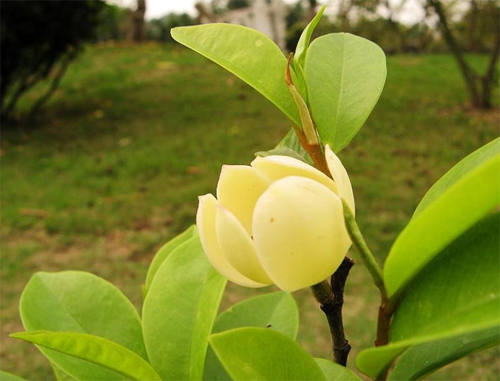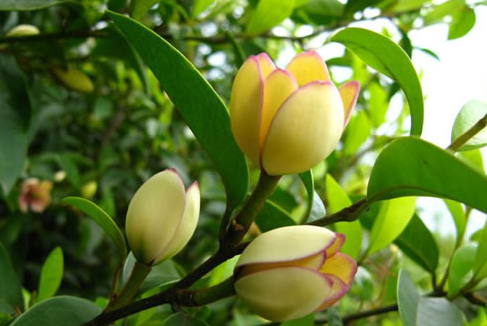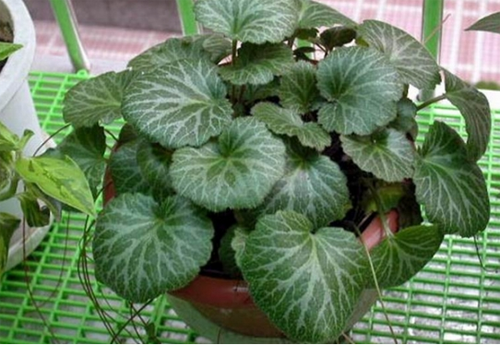The propagation method of Michelia mollissima what about the black rot of yellow leaves
Smile flower this name is not just like a lady, a little shy feeling, smile flower how to reproduce it? What if black rot and yellow leaves appear in the breeding process?

The method of propagation of Michelia flowers:
1. Cutting propagation
Cutting method is suitable for late July to early September, take not yet sent out new buds, but there are 3 to 8 leaves of lignified branches or terminal buds about 15 cm, in the base of the cuttings stained with rhizogenin inserted in sandy soil, and appropriate shade and keep the environment moist, about 2 to 3 months can take root, and then transplanted in the following spring.
2. Circle propagation
In April, 2-year-old branches with well-developed, well-organized and robust tissues were selected. girdling 0.5cm wide at proper position of branch, reaching xylem deeply, applying moist bryophytes to girdling position, wrapping it with plastic film, tightening up and down, rooting about 2 months. After the new roots fully develop, cut off the upper pot cultivation, after cultivation to irrigate water, after watering once a day or not watering. Fertilization began when the shoots were about 7cm long.
3. Grafting propagation
Grafting, which is less commonly used in the industry, should be implemented between May and June, often with magnolia as rootstock, which can grow rapidly after survival. Michelia flowers with thick and fleshy roots are not resistant to transplantation. If it is necessary to transplant, it is appropriate to bring more soil balls, and the pruning and shaping of plants are appropriate before winter.
Mio flower pest control:
Michelia flower common disease leaf blight, anthracnose, etc., when the disease occurs, immediately remove the diseased leaves burned, spraying medicine.
In early spring, the mixture of sulfur and stone was sprayed every 15 days, and zinc was sprayed after the disease occurred.
Anthrax onset period can be used Bordeaux mixture or Baiyinqing spray, every 10 days left spray 1.
To prevent and control coal pollution disease, we should clean up sick leaves and focus on pest control. When the pests are light, clean water can be used, and proper ventilation and light transmission should be paid attention to. When the disease is serious, spray it with special solution of bacteria withdrawal, spray once every 10 days, 2-3 times.
What about yellow flowers and black rot?
Michelia flower diseases are black mold, yellow disease, etc., can spray Bordeaux mixture, or with 5% alcohol scrub mold stain;
Control of chlorosis by spraying ferrous sulfate solution.
The main pests are scale insects, aphids and red spiders, etc., available 80% dichlorvos 1000~1500 times liquid spray kill.
When controlling, we should first cut the dense branches properly to make the tree ventilated and transparent. When the pest is light, it can be gently removed by manual brush; during the incubation period of nymph, 40% omethoate emulsifiable concentrate can be sprayed with 2000 times solution to kill it.
Michelia flower propagation methods and some pest control methods are introduced here.
How about the yellow leaves?
Fendai leaf is a very famous foliage plant, all like breeding, Fendai leaf leaves are two colors, no matter what season is not withered leaves. What is the cultivation method of Fendai leaves? What if there are rotten roots and yellow leaves in the process of cultivation?
The cultivation method of powder leaves:
Like warm and humid environment, indoor maintenance can often spray water, but the leaves are quite drought-resistant, generally kept in a bright place with ventilation, exposure is easy to hang off, the leaves will be scorched.
In addition to summer, other seasons can see a little light, basin soil drainage can be good, temperature above zero can survive.
1. Selection of basin soil
Potted with organic humus soil best, sandy soil mixed humus soil grow best, drainage must be good, can not accumulate water, planting is not so particular, find a shady place to plant.
2. Sunlight and Temperature
It is a relatively shade-tolerant indoor plant, can not be exposed to the sun, raised in the shade ventilation best, can see a little light, winter to keep warm, but also to avoid cold wind and freezing damage, its best growth temperature 20~28 degrees, winter moved into indoor cultivation.
3. Watering and fertilizing
This plant likes a slightly moist and warm environment. If the environment is too dry, the leaves are easy to burn. If the pot soil is not loose or accumulated, the leaves are easy to yellow. Usually, watering is dry and thorough. You can spray water frequently.
Do not need frequent fertilization, but also follow the principle of thin fertilizer and less fertilizer, spring and autumn fertilizer can be applied once.
4. Pay special attention to:
Its whole plant is poisonous, do not eat by mistake, its juice is easy to make skin itching, do not drip into the eyes, or eat by mistake.
Change basin to wear gloves or after disinfection wash hands, the usual point of contact will not have any effect, this and drip Guanyin a kind (Araceae plants are mostly poisonous, do not eat by mistake there is no big problem).
5. Introduction to reproduction
The propagation of this plant was simply not too simple. A random section could grow in hydroponic or slightly moist sand.
Like the picture above, it is possible to break off a section or divide plants when changing pots.
Remove the leaves from the lower part of the broken roots, dry the wounds and put them on the basin, basically they can survive.
Of course, there are also more extreme flower friends, directly cut off, sometimes when planting too fast will be cut off, let it grow new buds, don't worry about it hanging off easily, its buds soon grow out!
And then it'll fill up again.
Re-cuttage will soon be able to grow lateral buds, selection of breeding soil must be loose, drainage, ventilation.
What about rotten roots and yellow leaves?
Its pests are few, generally caused by improper maintenance of yellow leaves and rotten roots, rotten stems, yellow leaves are usually watered too much, proper water control, ventilation, sultry environment will also yellow leaves!
There is exposure to yellow leaves zoom, find their own reasons.
Rotten roots are usually basin soil hardening, ponding, or watering too much, very few basin soil is not disinfected, bacteria infection.
Cut off the rotten parts in time, wash them, soak them in carbendazim (5 minutes), and then replant them in new pots.
The cultivation method of Fendai leaves and the treatment method of yellow leaves and rotten roots in the cultivation process are also introduced. Hurry up and cultivate Fendai leaves! The house is green all year round.
How do gardenia yellow leaves grow?
Gardenia also known as yellow gardenia, gardenia, in China's land we often see, now very popular with people's favorite, gardenia yellow leaves how to do it? Let me tell you something.
Reasons for yellow gardenia:
First, improper moisture
A, too much watering, in this case, the tender leaves of the mast flower are dark yellow and dull, but the old leaves have no obvious change. At this time, as long as the flowers are taken out of the pot and placed in a ventilated and cool place, they will be put back after the soil is dry.
b, lack of water, leaf tips or edges dry, hair dry, old leaves from bottom to top yellow fall off, but this situation new leaves grow more normal, at this time should be watered enough, watered thoroughly.
Second, improper lighting
A, the light is too strong, the leaves of the sun part of the yellow spots, then only need to move it to the shade maintenance can be restored, the new leaves will not have yellow spots.
B, lack of sunlight, then the leaves will turn yellow or even fall off, as long as put in the sun to supplement the sun can be.
Third, improper fertilization
A, fertilization too much, mainly in the new leaf tip appears brown, leaf fertilizer thick and dull, old leaves brown off. At this time, it is necessary to immediately stop fertilizing, and in serious cases, wash the soil to reduce the concentration. b, insufficient fertilizer, fertilizer deficiency will also cause yellow plants, such as iron deficiency, leaves are pale yellow or white, veins are still green, then spray 0.2%-0.5% ferrous sulfate water for control; magnesium deficiency, first old leaves yellow, then new leaves yellow, veins are still green, then spray 0.7%-0.8% boron magnesium fertilizer control.
Fourth, the temperature is too low, the temperature is too low will also cause leaf yellowing, as long as it can be moved into the temperature height.
Solution: Gardenia likes sunlight, but it is not suitable for receiving direct sunlight, so when planting in the ground, it should have a big tree shade environment, potted gardenia should be placed in a shady place for maintenance, not tightly placed on the balcony and sun terrace directly exposed to sunlight, otherwise gardenia will be vulnerable to burns causing yellow leaves and charred leaves.
Gardenia cultivation methods:
Place position: Gardenia flowers like warm and humid and sunny environment, avoid direct sunlight, otherwise it will cause leaves to wither, gardenia flowers can be placed in a place with scattered light.
Temperature: Gardenia growth temperature can not be too low, the appropriate temperature for the growth period of 18-22℃, winter temperature should be kept above 5℃, if below minus 10℃ will be frostbite, in the north, winter to do a good job of insulation measures.
Air humidity: Gardenia flowers like a humid environment, you can often spray water to Gardenia leaves, increase the air humidity of the surrounding environment.
Fertilization: Gardenia like fertilizer, but not one-time to add too much fertilizer, must be thin fertilizer and more.
Pruning: Gardenia flowers are luxuriant and leafy, so they should be pruned regularly. It is best to select 3 main branches when pruning, and cut off the root tillers to sprout new branches at any time. After flowering, the branches should be truncated in time. When the new branches grow out after three festivals, they should be picked to avoid blind growth.
- Prev

When will the culture method of Michelia flowers blossom
How can Michelia flower have such a magical name, in fact, this is normal, because this flower has always been budding, not completely open, when will it bloom? Michelia cultivation method: watering, usually to keep the pot soil moist, but should not be too wet. Because of its multiple fleshy roots
- Next

How to raise Saxifraga and how to treat powdery mildew
Saxifraga is very good-looking and clever. Saxifraga can be planted not only in the soil, but also in the water. How to raise Saxifraga? If there is powdery mildew in the process of breeding, how to treat it? How to raise Saxifraga? Suitable temperature, it likes warmth, generally above 15 degrees is the most comfortable
Related
- Fuxing push coffee new agricultural production and marketing class: lack of small-scale processing plants
- Jujube rice field leisure farm deep ploughing Yilan for five years to create a space for organic food and play
- Nongyu Farm-A trial of organic papaya for brave women with advanced technology
- Four points for attention in the prevention and control of diseases and insect pests of edible fungi
- How to add nutrient solution to Edible Fungi
- Is there any good way to control edible fungus mites?
- Open Inoculation Technology of Edible Fungi
- Is there any clever way to use fertilizer for edible fungus in winter?
- What agents are used to kill the pathogens of edible fungi in the mushroom shed?
- Rapid drying of Edible Fungi

